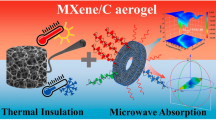Abstract
The effects of fiber electrical properties on electromagnetic wave absorbing potential in short Si–Ti–C–O fiber-dispersed epoxy matrix composites were studied. Six kinds of short Si–Ti–C–O fibers with different respective electrical resistivity were incorporated into an epoxy matrix and the dielectric properties of the composites in a frequency range from 1 MHz to 1 GHz were measured. The penetration depth of electromagnetic wave, which is defined as the distance to reduce 1/e of the incident electromagnetic wave power, is obtained from the measured dielectric properties. It is found that the dielectric properties of the composites are strongly dependent on the electrical resistivity of the fiber: the use of lower electrical resistivity fiber leads to a shorter penetration depth. Independent of the electrical resistivity of fiber, the penetration depth decreases with increase in the frequency. This result demonstrates the potential of the composite as a thin electromagnetic wave absorbing material.







Similar content being viewed by others
Notes
In the present composite, the fiber is distributed quasi two-dimensionally in-plane random-oriented and therefore the anisotropic property should be considered in the calculation. However, the article deals with only through-the-thickness direction, and therefore, Eqs. (1) and (2) give approximate values. The error associated with this assumption is neglected in this paper.
References
Shimizu Y, Suetake K (1970) Trans IEICE 53-B:143
Severin H (1974) IRE Trans Antennas Propagation AP–22:799
Tuley MT (1990) In: Radar cross section reduction short course notes. Georgia Institute of Technology
Naito Y, Suetake K, Fujiwara E, Sato M (1969) Trans IEICE 52–B:242
Hatakeyama M, Inui T (1984) IEEE Trans Magn 20:1261
Amin MB, James RJ (1991) The Radio and Electronic Engineer 51:209
Naito Y, Anzai H, Mizumoto T (1994) Trans IEICE J77-B-2:557
Shimizu Y, Hishikata A, Suzuki S (1985) Trans IEICE J68-B:928
Hashimoto O, Soh T (1991) Trans IEICE J74-B-2:563
Hashimoto O, Hara Y (1990) Trans IEICE J73-B-2:480
Hashimoto O, Sakai K (1992) Trans IEICE J75-B-2:599
Hashimoto O (1993) Trans IEICE J76-B-2:725
Shibuya M, Kajii S, Yamamura T (1993) In: Proceedings of the 3rd Japan International SAMPE Symposium. The society of material research, p 491
Mamiya T, Kagawa Y, Shioji Y, Sato M, Yamamura T (2000) J Am Ceram Soc 83:433
Ube industries, Ltd., private communication
Nagamuma T, Iba H, Kagawa Y (1999) J Mater Sci Lett 18:1587
Aharoni SM (1972) J Appl Phys 43:2463
Bueche F (1972) J Appl Phys 43:4837
Callister WD Jr (2000) In: Materials science and engineering, 5th edn. John Wiley & Sons, Inc., New York
Balberg I (1987) Philos Mag B 56:991
Von Hipper AR (1954) In: Dielectrics and waves. John Wiley & Sons, Inc., London
Born M, Wolf E (1980) In: Principle of optics, 6th edn. Pergamon Press, Oxford
Acknowledgements
The work was carried out under a grant from the Ministry of Education, Science, Culture, Sports, Science and Technology of Japan. The Si–Ti–C–O fiber was supplied by Ube Industries Ltd., Ube, Japan
Author information
Authors and Affiliations
Corresponding author
Rights and permissions
About this article
Cite this article
Kagawa, Y., Matsumura, K., Iba, H. et al. Potential of short Si–Ti–C–O fiber-reinforced epoxy matrix composite as electromagnetic wave absorbing material. J Mater Sci 42, 1116–1121 (2007). https://doi.org/10.1007/s10853-006-1437-1
Received:
Accepted:
Published:
Issue Date:
DOI: https://doi.org/10.1007/s10853-006-1437-1




